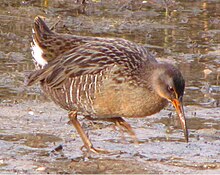Clapper rail
This article includes a list of general references, but it lacks sufficient corresponding inline citations. (November 2010) |
| Clapper rail | |
|---|---|

| |
| Scientific classification | |
| Kingdom: | Animalia |
| Phylum: | Chordata |
| Class: | Aves |
| Order: | Gruiformes |
| Family: | Rallidae |
| Genus: | Rallus |
| Species: | R. crepitans
|
| Binomial name | |
| Rallus crepitans JF Gmelin, 1789
| |

| |
The clapper rail (Rallus crepitans) is a member of the rail family, Rallidae. The taxonomy for this species is confusing and still being determined. The Ridgway's rail (formerly the California clapper rail) and the mangrove rail have been recently split. Furthermore, some taxonomists consider that the King rail and Aztec rail should be considered within this group, as those birds look similar and the birds are known to interbreed where they share territories.

Distribution and habitat[]
The clapper rail is found along the Atlantic coasts of the eastern U.S., the Gulf of Mexico, eastern Mexico, some Caribbean islands, and south through eastern Central America, as well at several inland locales.
Populations are stable on the East Coast of the U.S., although the numbers of this bird have declined due to habitat loss.
Clapper rails are saltmarsh specialists, and are highly mobile across their range, with females showing weak philopatry and a lack of philopatry in males. [2]
Subspecies[]
Currently named subspecies of the clapper rail (Rallus crepitans) include:[3][4]
- Rallus c. belizensis—Ycacos clapper rail; Ycacos Lagoon, Belize
- Rallus c. caribaeus—Caribbean clapper rail
- Rallus c. coryi
- Rallus c. crepitans, nominate
- Rallus c. grossi
- Rallus c. insularum
- Rallus c. leucophaeus
- Rallus c. pallidus
- Rallus c. saturatus—Gulf Coast clapper rail; U.S. Gulf Coasts of southwest Alabama through Texas, and of Tamaulipas (México).[5]
- Rallus c. scottii
- Rallus c. waynei


Description[]
The clapper rail is a chicken-sized bird that rarely flies. It is grayish brown with a pale chestnut breast and a noticeable white patch under the tail. Its bill curves slightly downwards.
Behaviour[]
Feeding[]
These birds eat crustaceans, aquatic insects, and small fish. They search for food while walking, sometimes probing with their long bills, in shallow water or mud.
Breeding[]
The twig nest is placed low in mangrove roots, and 3-7 purple-spotted buff eggs are laid.
References[]
- Rails by Taylor and van Perlo, ISBN 90-74345-20-4
- ^ BirdLife International (2018). "Rallus crepitans". IUCN Red List of Threatened Species. 2018: e.T62155296A132306811. doi:10.2305/IUCN.UK.2018-2.RLTS.T62155296A132306811.en. Retrieved 12 November 2021.
- ^ Coster, S.S.; Welsh, A.B.; Costanzo, G.; Harding, S.R.; Anderson, J.T.; Katzner, T.E. (2019). "Gene flow connects coastal populations of a habitat specialist, the Clapper Rail Rallus crepitans". Ibis. 161 (2): 66–78. doi:10.1111/ibi.12599.
- ^ Encyclopedia of Life—EOL.org: Information on Clapper Rail (Rallus longirostris) and subspecies . accessed 6.4.2014
- ^ Gwannon.com: Taxonomy of Rallus longirostris Archived 2014-06-06 at the Wayback Machine — subspecies and distributions . accessed 6.4.2014
- ^ GBIF.org: Distribution map for Gulf Coast Clapper Rail (Rallus longirostris saturatus)
External links[]
| Wikimedia Commons has media related to Rallus crepitans. |
- IUCN Red List least concern species
- Rallus
- Native birds of the Southeastern United States
- Birds of Belize
- Birds of the Yucatán Peninsula
- Birds of the Caribbean
- Birds of Hispaniola
- Birds of the Dominican Republic
- Birds of Haiti
- Birds described in 1789
- Taxa named by Johann Friedrich Gmelin
